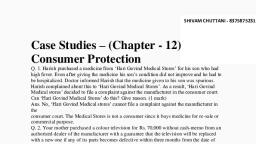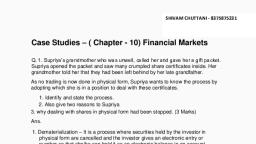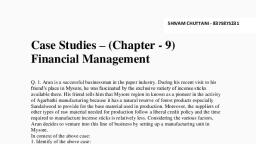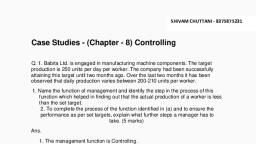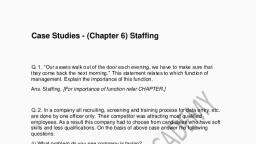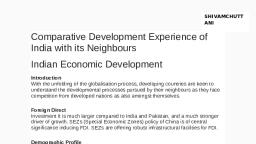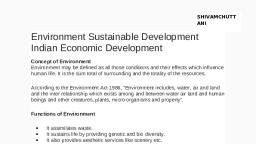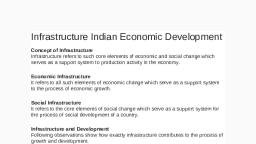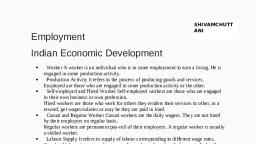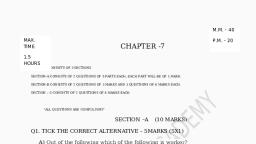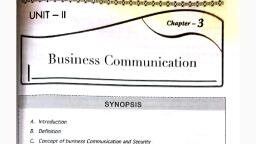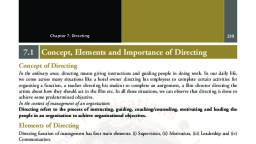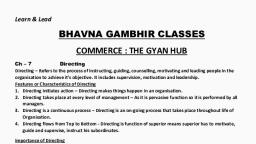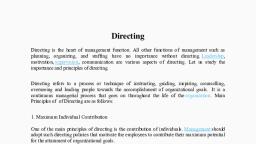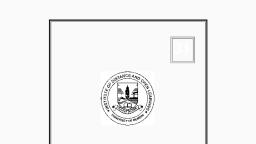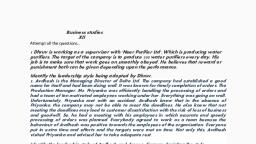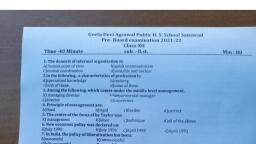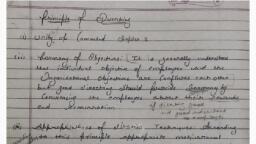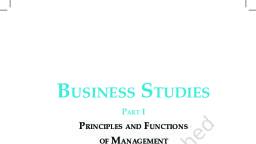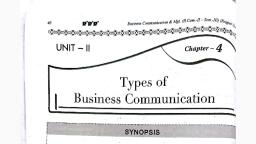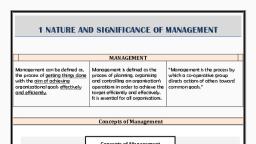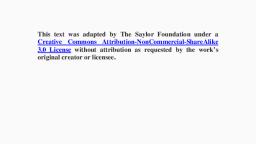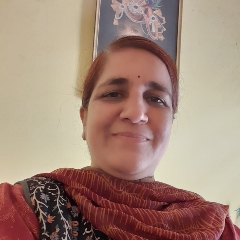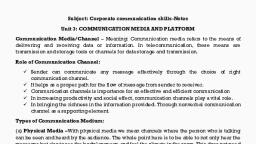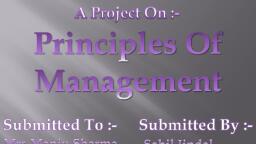Page 1 :
SHIVAM CHUTTANI - 8375875231, , Case Studies – (Chapter 7) Directing, Q. 1. Ayesha Ltd. Assured their employees that in spite of recession no, worker will be retrenched from the job., (i) Name and explain the type of incentive offered to the employees., (ii) Explain one more incentive of the same category., , Ans. (i) Job security, (ii) Explain one more incentive of the same category., 1. Employee’s recognition., 2. Organizational climate., , Q. 2. Blue Birds Ltd. Offers to its employees issue of shares at a price which is less, than the market price., (i) Name and explain the type of incentive offered to the employees., (ii) Explain one more incentive of the same category., , Ans. (i) Co-partnership/Stock option., (ii) Other incentives: (a) Pay and allowance, (b) Bonus., , Q. 3. ABC Ltd. Is not able to achieve its objective on analyzing, they found that, employees were not given their best, so he decided to announce an incentive plain,, which offers various incentives to employee workers at different level for achieving, their target., (i) Which element of directing is used by manager?, (ii) Suggest incentive suitable for:, 1. Employees operating at lower level., 2. Employees operating at higher level., , Ans. (i) Motivation is missing., (ii) (a) Lower level: offer monetary incentives.
Page 2 :
SHIVAM CHUTTANI - 8375875231, , (b) Higher level: non-monetary incentive., , Q. 4. Mr. John faced lot of problems regarding the policy on teaching. He directly, consulted the principal about his problem ignoring the Headmistress who is, immediate superior of Mr. John as he feels more free to communicate with, principal., (i) Name the pattern of communication followed by Mr. John., (ii) State any other two patters., , Ans. (i) Mr. John is following inverted ‘V’ pattern., (ii) Other two pattern:, 1. Wheel pattern, (b) Chain pattern., , Q. 5. Is directing required at planning stage? Name the element of directing, function under which:, (i) the superiors oversee the activities of their subordinates., (ii) the superiors assure the subordinates that their needs will be taken care of., (iii) the superior attempts to influence the behavior of people at work towards the, realization of specified goals., (iv) the superior share information with the subordinates in order to reach, common understanding. (3 Marks), Ans. No, directing is not required at planning stage since it is an executive, function. It initiates action in the organization while other functions of, management (planning, organizing, staffing and controlling) just prepare a, setting for action., 1. Supervision (ii) Motivation (iii) Leadership (iv) Communication., , Q. 6. Amit and Mikki are working in the same organization but in different, departments. One day at lunch time Mikki informed Amit that due to computerization, some people are going to be retrenched from the organization., Name which type of communication is this. State any two limitations of this, type of communication. (3 Marks), , Ans. Informal Communication
Page 3 :
SHIVAM CHUTTANI - 8375875231, , Limitations:, 1. The grapevine/informal communication spreads rapidly and sometimes, gets distorted. It is very difficult to detect the source of such communication., 2. It also leads to generate rumours. People’s behavior is affected by, rumours and informal discussion and sometimes may hamper work, environment., , Q. 7. You are working at the middle level of management. Your superior, a top, management personnel, sent a message for you which you received and well, understood. Is the communication process complete? Give reason., (3 Marks), , Ans. No, the communication process is not complete unless and until feedback is, given to the superior. Feedback includes all those actions of the receiver indicating, that he has received and understood the message of sender. So, I must respond, to communication to improve its effectiveness, e. g., by giving a reply to letter,, giving reactions to the message, etc., , Q. 8. Rakesh is working under his superior Neeraj. He always communicates useful, ideas and suggestions to his superior regarding reduction of cost, improvement in, the product, etc. Neeraj implements his suggestions and has always found, favourable results, but he never, appreciates Rakesh for his suggestions. Now Rakesh decided not to, communicate any suggestion or idea to Neeraj. Identify the factor which acts as, a communication barrier. (1 Marks), , Ans. Lack of proper incentives (Personal Barriers to Communication), , Q.9. Ankur is working as a production manager in an organization. His subordinate, Saurabh discussed with hi a method o production which will reduce the cost of, production. But due to some domestic problems and Ankur’s mind being preoccupied he is not in a position to understand the message. Saurabh got, disappointed by this. Identify the factor which acts as a communication barrier. (1, Marks), , Ans. Lack of attention (Psychological/Emotional Barriers to Communication), , Q.10. Rajat a Sales Manager, achieved his sales target one moth in advance., This achievement as displayed on the notice board and the CEO of the
Page 4 :
SHIVAM CHUTTANI - 8375875231, , Company awarded a certificate for the best performance to him. Name the, incentive provided to Rajat. (1 Marks), , Ans. The incentive provided to Rajat is – ‘Recognition’., , Q. 11. A behavior study was done on total of 100 employees of an organization., Group A (of 50 employees) were appreciated by the manager for their work and, initiative for new idea. All these employees were given option of flexible working, hours and were paid wages at a higher piece rate. On the other hand, Group B (of, remaining 50 employees) was criticized for their poor performance. Their, increments were stopped and they were paid wages at a lower piece rate., (a) Identify and explain the feature of motivation highlighted in the above case. (b), What type of leadership is followed by the manager? Justify your answer. (4, Marks), Ans., 1. Motivation can be either positive or negative. Positive motivation provides, positive rewards like increase in pay, promotion, recognition, etc. Negative, motivation uses negative means like punishment, stopping increments,, threatening, etc. 2. Autocratic leadership style., The leader’s following is based on the assumption that reward or punishment both, can be given depending upon the result., , Q. 12. In a company, Mr. Kshitij always explains management policies to workers, and brings workers’ problems to the notice of management. At what post does Mr., Kshitij work in this company? (1 Marks), , Ans. Mr. Kshitij is supervisor in the company as he acts as a link between, workers and management., , Q. 13. Prachi is working in an MNC. She has been given an option to buy the, shares of the company at an amount less than the market price because of her, performance as an incentive. Identify which incentive is being given to her. (1, Marks), , Ans. Co-partnership/Stock option.
Page 5 :
SHIVAM CHUTTANI - 8375875231, , Q. 14. Ms. Snigdha, Production Manager and Mr. Sarthak, Marketing manager of, an electronics company are not on talking terms with each other. Because of that, they do not transfer complete information to each other., (a) Identify the element of directing which becomes ineffective due to the, behavior of the managers., (b) Also, explain the factor which led to their such behavior. (3 Marks) Ans. (a), , Communication, , 1. Distrust (Psychological barrier), Distrust between sender and receiver causes failure of communication.If they do not, believe each other, they cannot understand each other’s message in its original, sense., , Q. 15. Huma is working in a company on a permanent basis. As per job agreement, she had to work for 8 hours a day and was free to work overtime. Huma worked, overtime, due to which she fell ill and had to take leave from her work. No one, showed concern and enquired about her health. She realized that she was fulfilling, only some of her needs while some other needs still remained to be fulfilled., (i) By quoting the lines from the above para, identify the needs of Huma which she, is able to fulfil., (ii) Also explain two other needs of Huma followed by the above needs, which still, remained to be satisfied., , Ans., 1. ‘Huma is working in a company on a permanent basis’., According to above line Huma is able to fulfil her following needs:, (a) Physiological needs(b) Safety or Security needs, (ii) Needs of Huma which still remained to be satisfied are:, 1. Affiliation Need: It refers to the need for affection, since to belongingness,, acceptance and friendship., 2. Esteem Need: It refers to the need for self-respect, autonomy, status, recognition, and attention.
Page 6 :
SHIVAM CHUTTANI - 8375875231, , Q. 16. Mr. Nath, a recently appointed production manager of Suntech Ltd. Has, decided to produce jute bags instead of plastic bags as these are banned by the, government. He set a target of producing 1000 jute bags a day. It was reported that, the employees were not able to achieve the target. After analysis he found that, employees were demotivated and not putting in their best for achieving the target., Mr. Nath’s beaviour is good towards the employees. His attitude is always positive., So he announced various incentive schemes for the employees like;, ● Installing award or certificate for best performance., ● Rewarding an employee for giving valuable suggestion., ● Congratulating the employees for good performance., 1. Identify the functions of management highlighted in the above, paragraph. 2. State the ‘incentive’ under which the employees are, motivated., 3. State any two values which the production manager wants to communicate to, the society by his work and behavior., , Ans., 1. Directing and Controlling, 2. Employee recognition programme (non-monetary incentive), 3. Vale:, ● Sensitivity of environment, ● Good behavior towards employees., , Q. 17. NOTICE, A meeting of all supervisors is scheduled on 20th August, 2016, , This notice was placed on the notice board in the reception area of XYZ Ltd. But it, did not mention clear specification regarding the time of meeting. Which barrier of, communication is referred to here? Explain any two other forms of barriers to, effective communication under the same category., (5 Marks), , Ans. Badly expressed message (Semantic barriers) – Use of wrong words,, omission of needed words, inadequate vocabulary, etc., 1. Symbols with different meanings: A work may have several meanings. For, example, consider these three sentences where the work ‘value’ is used:, ● What is the value of this ring?, ● I value our friendship., ● What is the value of learning compute skills?
Page 7 :
SHIVAM CHUTTANI - 8375875231, , Wrong perception by the receiver leads to communication problems., 1. Faulty translations: Sometimes, the communications originally drafted in one, language (say, English) need to be translated to the language, understandable to workers (say, Hindi). If the translator is not proficient with, both the languages, communication becomes ineffective., , Q. 18. Mr. Sandeep is the marketing manager of a company manufacturing, designer clothes. One day, in the morning while leaving home he had a quarrel with, a person in his neighbourhood on some issue. That person is a criminal who could, abuse his family members. Mr. Sandeep, on that day, is very worried and angry too, on the behavior of the neighood person. On that day, a meeting was held by a team, of marketing and design experts to ensure that whatever is produced is according, to market demand and tastes and fashion of the customers. But Mr. Sandeep could, not pay attention to the discussion between them., (a) Identify the type of barriers to communication mentioned in the above para., Justify your answer., (b) Explain any two such barriers to communication., , Ans., 1. Psychological barriers., These are related to the state of mind of both sender and receiver of, communication.For example, a worried person cannot communicate properly, and an angry receiver cannot understand the real meaning of message., ‘Mr. Sandeep is very worried and angry on that day.So he could not pay, attention to the discussion in the meeting.’, 1. Psychological barriers to communication:, 1. Lack of attention: the pre-occupied mind of receiver and the resulting nonlistening of message acts as a major psychological barrier., 2. Premature evaluation: Sometimes people form a judgement before the, sender completes his message, which causes failure of communication., , Q. 19. Mrs. Rajlaxmi is working as the Human Resource Cosultant in a firm, manufacturing cosmetic, which is facing a problem of high employee urnover. The, CED of the company has invited suggestions from her for retaining the talented, employees & reducing the, employee turnover. Mrs. Rajlaxmi recommends that the good employees be, rewarded in a way that it creates a feeling of ownership among the employees and, at the same time makes them contribute towards the growth of the organization., (a) Identify the incentive and explain its type, which has been suggested by Mrs., Rajlaxmi to the CEO of the company.
Page 8 :
SHIVAM CHUTTANI - 8375875231, , (b) Also explain any two other incentives of the same type., , Ans., 1. Financial incentive., Co-Partnership/Stock Option, 1. Other financial incentives:, 1. Pay and allowances: For every employee, salary is the basic financial, incentive. It includes basic pay, dearness allowance and other allowance., Pay hike and increments improve performance level of employees., 2. Profit sharing: Employees are given a share in the profits of the organization., This motives them to improve their performance and contributes to increase in, profits of the organization., , Q. 20. Mr. Bhuvan is the marketing manager of the company manufacturing, designer clothes. One day in the morning while leaving home, he had a quarrel with, the person in the neighbourhood. That person abused his family and threaten to, harm the family. Mr. Bhuvan got very upset and worried. On the same day a meeting, was organized in the office to finalise the design according to market demand and, taste the fashion of the customers. Mr. Bhuvan could not pay attention to the, discussion as he was thinking about the quarrel only., (a) Identify the type of barrier to communication mention in the, above para. (b) State any other two barriers of same category., , Ans., 1. Psychological barrier Lack of attention., 2. (i)Premature evaluation, (ii) Loss by poor retention., , Q. 21. Rajiv is working as Personal Manager in a company. The specialty of the, company is that financial position of all the employees is good. The employees, working here are honest punctual and hardworking. The CEO of the company asked, him to suggest a method of motivation. The CEO asked him to suggest a method, which is happily accepted by all the employees., Rajiv spoke to many employees in this connection. Some employees suggested, give more importance to individual autonomy, another suggested good performance, should be appreciated another group suggested to award, certificate, trophies to, recognize the good performance. Mr. Rajiv mixed all and suggested a method of, motivation to CEO. The CEO happily accepted that and it was immediately
Page 9 :
SHIVAM CHUTTANI - 8375875231, , implemented. With in few days the company’s growth rate appeared to have, become fast., 1. Identify the functions of management indicate in the above paragraph., 2. Which motivation methods were suggested by different group of, employees. 3. Which motivation method combine all the above stated and, was suggested by personal manager., Ans., 1. Directing., 2. (i) Recognition, (ii) Autonomy, 1. Organizational climate., 2. (i) Ethical behavior, (ii) Motivating employees, (iii) Taking Suggestions from employing., , Q. 22. Pramod was a supervisor at a ‘Annapurna Aata’ factory. The factory was, producing 200 quintals of Aata every day. His job was to make sure that the work, goes on smoothly and there was no interruption in production. He was a good, leader who would give orders only after consulting his subordinates and work out, the policies with the acceptance of the group., Identify and describe the leadership style being adopted by Pramod., Ans. Democratic style of leadership., ● A democratic leader favours decision making by the group. This improves the, attitude of the employees towards their jobs and the organization thereby, increasing their morale., ● Using this style is of mutual benefit – it allows them (subordinates) to become, part of the team and helps leaders (seniors) to make better decisions., , Q. 23. Neeraj, a sales representative of ‘Omida Ltd’ has changed seven jobs in the, last one year. He is a hard working person but is not able to finalise deals with the, customer due to his inadequate vocabulary and omission of needed words., Sometimes he uses wrong words because of which intended meaning is not, conveyed. All this created a mis-understanding between him and his cliens., (a) Identify the communication barrier discussed above., (b) State the category of this communication barrier., (c) Explain any other communication barrier of the same category.
Page 10 :
SHIVAM CHUTTANI - 8375875231, , Ans., 1. Badly expressed message, 2. Semantic barrier, which arises from problems and obstructions in the, process of encoding and decoding of message into words or impressions., 3. Technical jargon; Specialists use technical language or jargon while explaining to, the workings, e.g., tariff, quotas, etc. therefore, they may not understand the, actual meaning of many such words., , Q. 24. Smita had been working as an assistant manager with ‘Johnson Enterprises’, for the last ten years. She was very popular amongst her colleagues because of her, commitment and dedication towards the work. When the manager senior to her, retired, all her colleagues thought that now Smita would be promoted. But to, everyone’s surprise the vacant post was filled by an outsider, Mrs. Rita. Smita felt, demoralized and her performance started declining. She would abstain herself often, and could not meet her targets., Mrs. Rita was a good leader, who would not only instruct her subordinates but, would also guide and inspire them. She noticed Smita’s hebaviour and felt that her, performance could be improved. She started involving Smita in decision makingissues related to the organization and made her a part of high level jointmanagement committed. Smita was now punctual in office and her performance, started improving., 1. Identify the function of management being performed by Rita., 2. Name the element of the above function of management which helped, Rita to improve Smita;s behavior., 3. State any three features of the element identified in (ii) above., Ans., 1. Directing, 2. Motivation, 3. Features of motivation:, 1. Motivation is an internal feeling: The urge, desires, aspirations or needs of, people, which are internal, influence human behavior., 2. Motivation produces goal-directed behavior: For example, if the employee is, interested in promotion, it helps to produce a behavior to improve, performance. 3. Motivation can be either positive or negative: Positive, motivation provides positive rewards like increase in pay, promotion,, recognition, etc. negative motivation uses negative means like punishment,, stopping increments, threatening, etc., , Q. 25. Rahim was working in an enterprise on daily wages basis. It was difficult for, him to fulfill the basic needs of his family. His daughter fell ill. He had no money for, his daughter’s treatment. To meet the expenses of her treatment, he participated in, a cycle race and won the prize money. The cycle company offered him a permanent, pensionable job which he happily accepted.
Page 11 :
SHIVAM CHUTTANI - 8375875231, , (i) By quoting the lines from the above para identify the needs of Rahim that are, satisfied by the offer of cycle company., (ii) Also, explain two other needs of Rahim followed by above that are still to be, satisfied. Ans., 1. Needs of Rahim that are satisfied by the offer of cycle company are Physiological, and safety/security needs., ‘The cycle company offered him a permanent pensionable job’., 1. The other needs followed by the above stated needs that are still to be, satisfied are: 1. Affiliation/Belongingness needs: These needs refer to the need, for affection, sense of belonging, acceptance and friendship., 2. Esteem needs: These needs refer to the need for self-respect, autonomy, status, recognition, etc., , Q. 26.Y Ltd. Is a bank functioning in India. It is planning to diversify into insurance, business. Lately, the government of India has allowed the private sector to gain, entry in the insurance business. Previously, it was the prerogative of LIC and GIC to, do insurance business. But now with liberalization of the economy and to make the, field competitive other companies have been given licences to start insurance, business under the regulation of ‘Insurance regulatory and development Authority’., Y Ltd. Plans to recruit high quality employees and agents and exercise effective, direction to capture a substantial part of life and non-life insurance business., 1. Identify how the company can supervise its employees and agents, effectively. 2. What financial and non-financial incentives can the company use, for employees and agents separately to motivate them?, 3. How can the company ensure that higher order needs i.e., esteem and, self actualization as specified by Maslow are met?, 4. How can the company follow formal communication system?, 5. How can informal communication help to supplement formal communication?, , Ans., 1. The company will appoint supervisors who will provide on the job training to the, employees and agents. They will maintain group unity and ensure that the, company gets enough insurance business., 2. To the employees, the company can give pay and allowances, bonus,, retirement benefits, perquisites (e.g., car allowance),recognisation, promotion,, job security etc. to motivate them for higher performance., To the agents, the company can give the following incentives:, 1. Profit sharing
Page 12 :
SHIVAM CHUTTANI - 8375875231, , 2. Stock option (i.e., giving company’s share at a price less than market, price) 3. Productivity linked salary (i.e., higher salary for getting more, insurance business) 4. Participation in decision – making., 1. By giving recognition, autonomy status, etc. and providing growth and selffulfillment opportunities, the company ensures that higher order needs-esteem, and self actualization needs are met., 2. The company can follow formal communication system by ensuring that all, communication flows through official channels designed in the organization chart, (i.e., through Scalar chain)., 3. Information communication network (i.e., grapevine) can be used by the, company to transmit information to know he reactions of the employees and, agents to the company’s decisions and policies. Grapevine channels can carry, insurance market information rapidly., , Q. 27. Prateek is working in a multinational company in Noida. He was running a, temperature for the last many days. When his blood was tested, he was found to be, positive for malaria. He was admitted in a hospital and a blood transfusion was, advised by the doctors as his condition was very serious. One of his colleagues sent, a text message to his superior, Mr. B. Chatterjee. Mr. B. Chatterjee immediately sent, a text message to the employees of the organization requesting them to donate, blood for Prateek. When the General Manager came t o know about it, he ordered, for fumigation in the company premises and cleaning the surroundings., 1. From the above paragraph, quote lines that indicate formal and, informal communication., 2. State any two features of informal communication., 3. Identify any two values that are being communicated to society in the, above case. Ans., 1. (i) Informal communication: “One of his colleagues sent a text message to his, superior, Mr. B. Chatterjee. Mr. B. Chatterjee immediately sent a text message, to the employees of the organization requesting them to donate blood for, Prateek.”, (ii) Formal communication: “When the general manager came to know about it, he, ordered for fumigation in the company premises and cleaning surroundings.”, 1. The features of informal communication are as follows:, 1. The grapevine/informal communication spreads very fast and sometimes, gets distorted., 2. It is very difficult to detect the source of such communication., 1. The two values that are being communicated to the society are:, 1. Humanity, 2. Cleanliness
Page 13 :
SHIVAM CHUTTANI - 8375875231, , Q. 28. Roshan is the chief of ‘Khidmat’ restaurant located in the city of Bangaluru., The place is known for its exquisite Mughlai cuisine especially mutton briyani and, kababs. All the food is prepared under Roshan’s purview. The various activities in, the kitchen are initiated in accordance to his instructions. He is very clear and, specific in issuing instructions to his subordinates in order to ensure smooth working, of the department. He personally oversees the method followed by the chefs for, preparation of each dish. He misses no opportunity to praise his subordinates for, their good work. All his team members feel very happy and satisfied under his, direction. He provides constant guidance to them in order to improve upon its taste, and presentation and also encourages them to innovate and be more creative in, their work., In the above context:, 1. Identify the various elements of directing mentioned in the above, paragraph by quoting lines from the paragraph., 2. Describe briefly any two points to highlight the importance of directing as a, function of management., Ans., 1. The various elements of directing mentioned in the above paragraph are as, follows: 1. Communication: ‘He is very clear and specific in issuing instructions, to his subordinates in order to ensure smooth working of the department.”, 2. Supervision: “He personally oversees the method followed by the chefs, for preparation of each dish.”, 3. Leadership: “He provides constant guidance to them in order to improve upon its, taste and presentation and also encourages them to innovate and be more, creative in their work.”, 4. Motivation: “He misses no opportunity to praise his subordinates for their good, work.” 1. The importance of directing as a function of management is described, below: 1. Initiates action: Directing helps to initiate action by people in the, organization towards, attainment of desired objectives. It is the first execution function of, management. 2. Integrates employees’ efforts: Directing seeks to integrate, the individual efforts of employees in the organization towards the realization, of the organizational goals., 3. Helps to realize their potential: Directing provides effective guidance, motivation, and leadership to the employees so as to enable them to realize their potential, and capabilities. (any two), Q. 29. Neeraj has been working as a sewing machine operator in an export house, for the past ten years. His basic work is to seam the parts of a garment together,, and attach buttons, hooks, zippers, and accessories to produce clothing., Considering the fact that Neeraj is an experienced operator, he is well versed with, the fundamentals of industrial production and possesses good communication, skills. The plant superintendent in the factory recommends Neeraj’s name to the, production manager for the post of supervisor which will fall vacant after a month, on the retirement of the present supervisor. Consequently, Neeraj is assigned the, post of supervisor and his salary is increased accordingly. Moreover, as per the, policy of the export house, he is offered free medical aid and education to his two, children.
Page 14 :
SHIVAM CHUTTANI - 8375875231, , In the context of the above case:, 1. Identify the type of source of recruitment used by the export house to fill up the, post of supervisor. Give any two advantages of using this source., 2. Identify the types of financial incentives offered to Neeraj by quoting lines from, the paragraph., Ans., 1. The internal source of recruitment has been used by the export house to fill up the, post of supervisor through promotion. The two advantages of using internal, source of recruitment are stated below., 1. Employees are motivated to improve their performance: When employees are, promoted internally from within an organization, it has a positive impact on their, commitment and loyalty and they tend remain satisfied with their jobs. Also, it, may lead to a chain of promotion at lower levels in the organization. As a result,, it motivates the employees to improve their performance through learning and, practice., 2. Internal recruitment simplifies the process of selection and placement: The, candidates can be appraised more perfectly and economically as that are, already working in the organization. As the candidates are already known to, the organization, it is considered to be a more reliable method of recruitment., 1. The types of financial incentives offered to Neeraj are as follows:, 1. Pay and allowances: “his salary is increased accordingly.”, 2. Perquisites: “as per the policy of the export house, he is offered free medical aid, and education to his two children.”, Q. 30. Sunidhi has started a designer studio in the basement of her residence after, completing her masters in fashion designing. She has appointed ten employees to, take care of the various aspects of the work. She interacts regularly with each, employee to tell exactly what is expected of him/.her and what he/she needs to do, to be regarded as a good performer. At the same time she allows a free work, environment wherein the employees openly chit chat with each other in order to, fulfil their social and emotional needs. Sometimes, these interactions also lead to, spreading rumours which are not authentic., In the context of the above case:, 1. Name and explain the two types of communication being referred to in the, above paragraph., 2. How does effective communication increases managerial, efficiency? Ans., 1. The two types of communication being referred to in the above paragraph are, formal communication and informal communication., 1. Formal communication: The communication that flows through official channels, designed in the organization structure is called formal communication. This, communication may take place between a subordinate and superior or among, same team employees or managers. Usually a written record of such, communications is maintained, recorded and filed in the office. Formal, communication may be further classified as – Vertical and Horizontal.
Page 15 :
SHIVAM CHUTTANI - 8375875231, , 2. Informal communication: Informal communication is the type of communication, that takes place without following the formal lines of communication. It is, generally referred to as the ‘grapevine’ because it spreads throughout the, organization with its branches going out in all directions in utter disregard to the, levels of authority. The informal communication arises out of needs of, employees to exchange their views, which cannot be done through formal, channels., 1. Effective communication increases managerial efficiency by lubricating the, working of the entire organization through quick and effective performance of, managerial functions. It enables the management to express the goals and, targets, issue instructions, allocate jobs and responsibilities and look after the, performance of subordinates., , Q. 31. Gagan has joined as a Managing Director of True Help Ltd., a company, engaged in the business of providing road side assistance to the vehicle owners., He was previously, working in an automobile company. As a part of the joining incentive, the, company has allotted him 400 shares of the company., In context of the above case:, 1. Identify the type of source of recruitment used by True Help Ltd. to fill up the, post of Managing Director., 2. Identify the type of financial incentive offered to Gagan. Also, state any one, other method that can be used to offer financial incentives to the employees., Ans., 1. External source of recruitment has been used by True Help Ltd. to fill up the, post of Managing Director., 2. Co-partnership/ Stock option is the type of financial incentive offered to, Gagan., The other method that can be used to offer financial incentives to the employees is, Bonus. Bonus is an incentive offered over and above the wages/ salary to the, employees., , Q. 32. Mr. Naresh is working as a Production Manager in Vohra Ltd. His, subordinates are mostly engineers and qualified technicians., As a manager, he is very strict, does not listen to any suggestions or feedbacks given, by his subordinates. He expects them to following his instructions without any, questions and does not allow them to give suggestions., 1. What leadership style does the manager follow?, 2. Is such a leadership style beneficial for the company? Explain., 3. State any one value being overlooked by him? (4 marks), Ans.
Page 16 :
SHIVAM CHUTTANI - 8375875231, , 1. Autocratic leadership, 2. This leadership style is effective in getting productivity in many situations like in a, factory where the supervisor is responsible for production on time and has to, ensure labour productivity. Quick decision-making is also facilitated., 3. Value overlooked:, ● Respect for other’s opinion, ● Initiative




